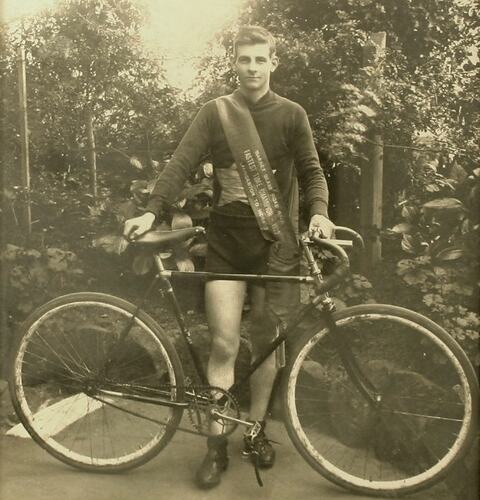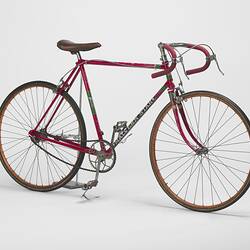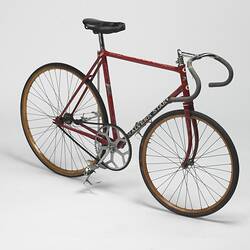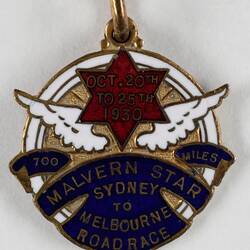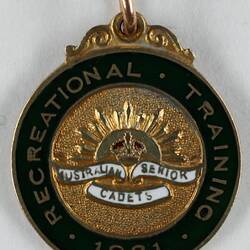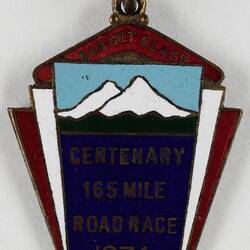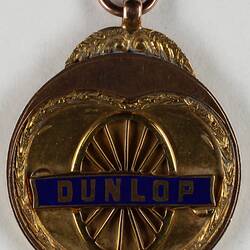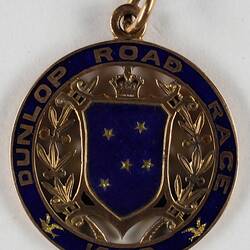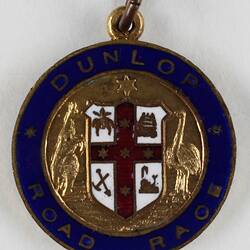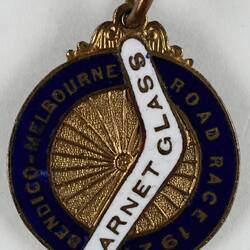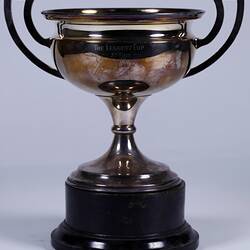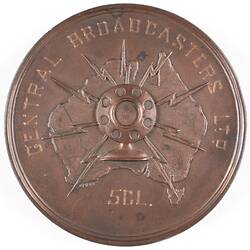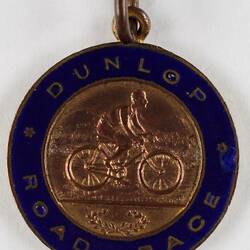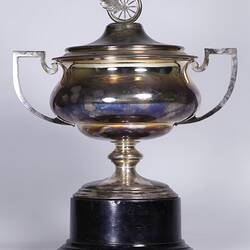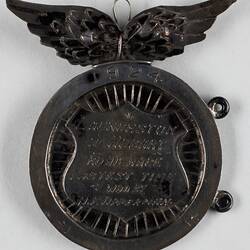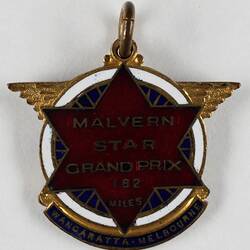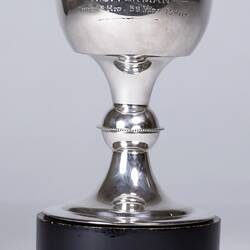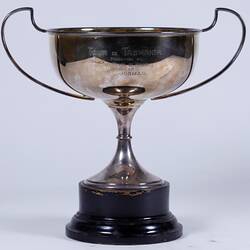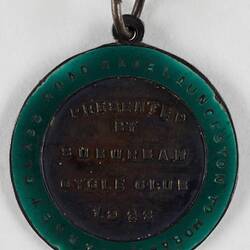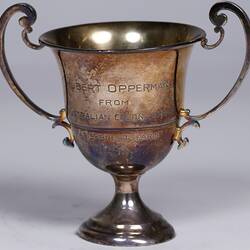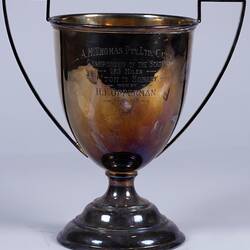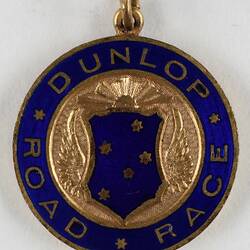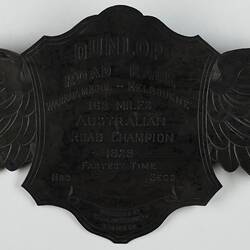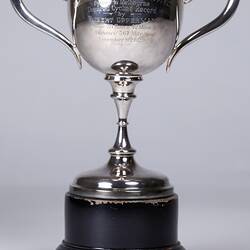Hubert Opperman was a much cherished Australian sporting hero of the 1920s and 1930s, whose cycling achievements inspired millions during the difficult Depression years. In 1922, as a relatively unknown 17 year old, Opperman achieved his first success with a third place in the gruelling Cycle Traders 100-mile (160-kilometre) road race, winning a new £10 Malvern Star sports bike. Thus began an association with Malvern Star that lasted half a lifetime and helped shape the destiny of both Opperman and the company he came to represent. Over the next two decades, 'Oppy' went on to win more than 50 major road races and hundreds of track events in Australia, England and Europe, establishing dozens of world records in the process. In 1931, Oppy donated to the museum the bicycles on which he had achieved two of his most significant world records. Later in life he subsequently followed this up with the donation of many of the trophies, sashes and certificates that he had won throughout his cycling career.
Hubert Ferdinand Opperman was born in Rochester, Victoria to Aldolphus Samuel Ferdinand Opperman and Bertha Opperman (née Reddie) in 1904. He had two younger siblings - Ellen and Otto (Alex). Opperman's father was a soldier and fuelled his Hubert's interest in cycling by bringing his son to the Annual A.N.A Cycling Carnival in 1912. Later in life, Opperman remembered this event fondly - recalling the soundtrack of the 'Missouri Waltz' in the background.
Becoming an Australian Champion
Opperman's first win as an amateur was achieved at 17 in the Victorian Senior Cadet Championship in 1921. Oppy had always mentioned this as the most emotional victory in his entire career. His first major professional races included the Bendigo to Melbourne and the Launceston to Hobart - the latter of which he won. During this early period Opperman built an alliance with Bruce Small, owner of Malvern Star Bicycles. This was a profitable and robust friendship for both parties. Bruce Small even wrote a book about his friend Hubert, entitled 'The Amazing Oppy: An Appreciation'.
Oppy was also lucky in love. He married his sweetheart Mavys Paterson Craig in 1928, and they had two children - Carole and Ian.
The Australian Road Championships (sponsored by Dunlop) was an annual event in which Oppy shined. The well-published, 261 km Warrnambool to Melbourne race had massive appeal in the mid 1920s, and still does. At Oppy's first attempt on the race in 1922, he received 4th place. He followed this up by winning the Blue Riband (fastest time) for the event in 1924, 1926, and 1929.
Heading Overseas
Opperman first competed in the 22-day, 3000km Tour De France race in 1928, finishing a credible 18th, being one of only 39 riders to finish the gruelling event, out of 169 starters. He would return to France for several more Tour de France campaigns during the 1930s, competing with both Australian and British teams and helping to put Australian cycling on the world map, despite fairly modest results. It was the sheer determination of Opperman and the Australian team that impressed the European cyclists. But this is just the tip of the iceberg!
The Bol D'or (Bowl of Gold) was a French, 24 hour, paced bicycle race that ran between 1894 and 1950. Opperman had a great victory in 1928, covering 950.06 kms in the allocated time. After receiving 18th place at the Tour de France, it was a particularly joyous win.
Paris-Brest-Paris was another notable race, stretching 1,161 kms from Paris to Brest and back. It was the most prestigious and well-published endurance race in the world during the early-mid 20th century. In 1931, Opperman won this race with a time of 49 hours and 20 minutes.
Oppy also won The Cycling Ashes in 1935. This was another 24-hour route, this time in England ('Land's End' to London). It coincided with the cricket 'Ashes' series.
Opperman also entered the Golden Book of Cycling in 1935 and won the Bidlake Memorial Prize (essentially a cyclist of the year award) and the 'Oppy Oscars', sponsored by Malvern Star (a.k.a. the Opperman All Day Trial) was created in his honour.
In separate publications, Oppy was voted by the public as a sporting hero by both French and Australian fans. A large reason for his heroic status was his undying endurance and multiple record-breaking performances. He was beloved in both hemispheres.
Some of Oppy's other notable records include:
- Completing 1000kms in 24 hours at the Melbourne Motordrome in 1932
- Taking 5 British records in two weeks (including London-Bath-London) in 1934
- Brisbane to Sydney, 651 miles in 47 hours 10 minutes, in 1936
- Records from Fremantle to Sydney, Kalgoorlie to Perth, Brisbane to Sydney, Adelaide to Sydney and more.
Post Cycling Career
The outbreak of the Second World War was to put an end to Opperman's cycling career, and led to the start of new pursuits. His later political career was to be one of almost as much variety and significance as his cycling career.
In 1940, Opperman joined the RAAF, starting as a Drill Instructor and later Pilot Officer, and rose to the rank of Flight Lieutenant. His term was over in 1945.
In between sports and politics, Opperman also was heavily involved in the Malvern Star brand, becoming the Personnel Manager in 1946 of Allied Bruce Small Ltd. He was also awarded a position in the Jubilee Sporting sub-committee in 1950.
Oppy's political pursuits began when he joined the 'People's Freedom' movement, which related to land in Moorabbin that was to be used to create an airport, despite protests from locals. Lord Casey, a candidate for a new party called the United Australia Party, and member of the seat of Corio, recommended that Opperman stand for the Liberal Party. Oppy did so and won the seat of Corio in 1949. He held the seat for 17 straight years (1949-1966). Opperman was described as a 'precocious young backbencher' by Malcolm Fraser. In 1956, he was also appointed as Government Whip.
Oppy was promoted five years later in 1961 to Minister of Shipping and Transport. His focus was on lowering the high road death tolls by promoting the use of seatbelts. In a candid statement, Opperman said that 'In the next decade, road tolls will equal half of the migration population intake' in addition to 'the road toll between 1945 and 1960 being 20% higher than Australian battle deaths from WWII'. Opperman was also adamant that bicycles should not require a licence. In fact, Oppy was instrumental in the creation of 'Bike Ed' programs in Primary Schools.
In 1964 Opperman became Immigration Minister for the Liberal Government, and pushed the idea of skilled migration as a real investment and advantage for Australia. During his period as Minister, laws were relaxed on Asian migration, and deals were made between Australian and Holland, as well as Malta.
Oppy's next role was as the High Commissioner to Malta, the first role of its kind for Australia. Opperman held this position from 1969-1972, moving overseas. Unfortunately, in the same year, Opperman also suffered cardiac arrest. At this point, he was almost 20 kg overweight and had experienced much public scrutiny and pressure.
Oppy was always a cyclist, despite his health not always being up to scratch. He even pressed for a 'cycling pool' being installed in Parliament to get the fitness of politicians up. He never lost his racing spirit, nor his '..unassuming personality and his unfailing sense of humour' as Bruce Small once put.
Knighthood and Retirement
Opperman received a Bachelor Knight by Knights of the Order of St John of Jerusalem in 1968, and a Knight Commissioner in 1974.
In his retirement, Oppy published his autobiography 'Pedals, Politics and People', was a Sporting Hall of Fame inductee, was selected as one of ten all-time greatest Australian sportspeople, and personally unveiled a bronze statue erected in his honour in his home town of Rochester, Victoria.
Sir Hubert Opperman died a month before his 92nd Birthday on his exercise bike, which his wife Mavys had forbidden him to ride.
Author: Kathleen Jessop
More Information
-
Keywords
-
Localities
-
Authors
-
Article types
